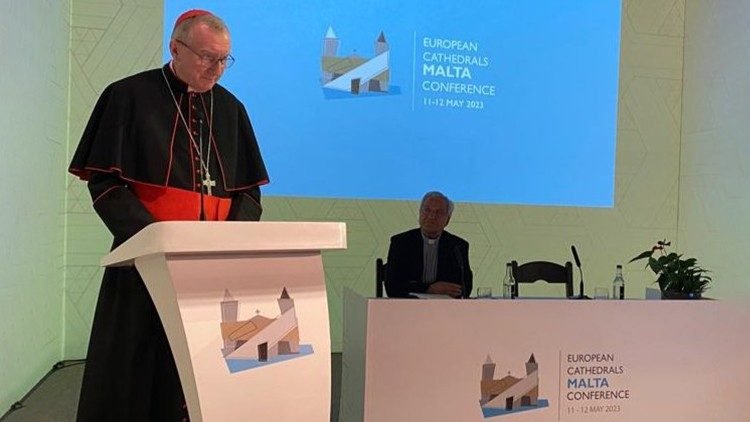Cardinal Secretary of State Pietro Parolin speaks at the opening of the conference “European Cathedrals Malta 2023: The Equilibrium between Conservation and Spirituality,” and says artists have always helped the Church translate its divine message into visible language.
By Fausta Speranza
Preserving the cultural heritage by preserving “the very profound relationship between art and spirituality” and contrasting the limited horizon of the “technocratic paradigm”: this is a summary of the appeal that Cardinal Secretary of State Pietro Parolin addresses to everyone – and in particular to “political decision-makers” – in the inaugural message at the Conference “European Cathedrals Malta 2023. The Equilibrium between Conservation and Spirituality”.
The conference takes place on Thursday and Friday at St. John’s Co-Cathedral in Malta.
In his address, Cardinal Parolin recalled that efforts aimed at the restoration and preservation of artistic objects cannot disregard the “conservation of the historical, cultural and religious meanings and values that those objects express”.
Quoting Michelangelo and Kandinsky, he emphasised how artists have always spoken of art in relation to sacredness, of “inner necessity”, of “spiritual impulse”, of response to the “spiritual hunger” of the human being. And he recalled that “all the major spiritual movements, including non-Christian ones, have exerted a great influence on art over the centuries”.
Artists, he said, “have helped the Church to translate its divine message into the language of forms and figures, making the invisible world palpable”, while “worship has always found in art a natural ally”.
The Cardinal went on to explain that “it is therefore no exaggeration to say that a value-based science of conservation is by its very nature a form of spirituality, since it aims to extend over time the values attributed to both the tangible and intangible dimensions of our cultural heritage”. First and foremost in these considerations, therefore, is the commitment of the Church as a “promoter and guardian of sacred art”.
Cardinal Parolin retraced significant stages in the Vatican’s commitment, citing the Holy See’s accession to the European Cultural Convention in 1962, the signing of the European Declaration on Cultural Objectives in Berlin in 1984, and the birth of the Pontifical Commission for the Conservation of the Church’s Artistic and Historical Heritage in 1993.
He also recalled the words addressed by Pope Paul VI to artists in 1964 in the Sistine Chapel: “Your craft, your mission, your art is precisely that of seizing the treasures of the heavenly realm of the spirit and cladding them in words, colours, form and accessibility” to “preserve the ineffability of such a world, the sense of its transcendence, its aura of mystery, this need to reach it with ease and effort at the same time”. He quoted Pope John Paul II along the same lines: “Artists participate in God’s creative craftsmanship through their works of art”.
Speaking in particular of the Pontifical Commission for the Cultural Heritage of the Church, Cardinal Parolin recalled the invitation to “re-read” the cultural heritage of the Church, “from the majestic cathedrals to the smallest objects; from the marvellous works of art of the great masters to the minor expressions of the poorest arts”.
And then there is Pope Francis’s invitation to think in terms of “encounter” and the necessary change of mentality and actions that – Cardinal Parolin suggested – translates on these issues into a precise recommendation.
“The encounter between those who work in conservation and the cultural heritage should not be conditioned by the technocratic paradigm that promotes mistaken attitudes, approaches and concerns limited only to the conservation of the physical fabric of artistic objects. Restorers and art custodians take care of both the physical and exterior dimension of our cultural heritage and its intangible and supersensible reality.”
The call is also strong in the encyclical Laudato si’, where – the Secretary of State pointed out – “Pope Francis laments how the current horizon of technocracy reduces all objects to efficiency, the pursuit of profit and consumerism”. The Pope emphasises that on the contrary “when wisdom prevails over technocratic arrogance, then the process of cultural preservation becomes an encounter with the sacred reality that manifests itself beyond superficial appearances’ and ‘the process of preservation becomes a spiritual experience of encounter with the mystery”.
“The goal”, Cardinal Parolin clarified, “is to ensure a common awareness and moral sensitivity among political decision-makers”, as Pope Francis reiterated on 20 December 2013 to Italian diplomats, encouraging them to “deploy the cultural heritage of art to spread a culture of encounter”.
Cardinal Parolin also said we shoudl consider future generations, citing the commitment of the Holy See’s Permanent Observer to UNESCO to promote the conviction that “approaches to conservation should not only seek to preserve the world of art as a bearer of beauty, but also, and above all, as a synthesis of religious and spiritual values that cannot disregard the encounter with the community to which it belongs and with its historical, geographical and architectural contexts.”
In conclusion, Cardinal Parolin expressed his hope that ‘”art will be an increasingly effective means of bringing those in search of meaning closer to the Gospel message and arouse in every person of good will that love of beauty that opens the spirit to truth and good.”



